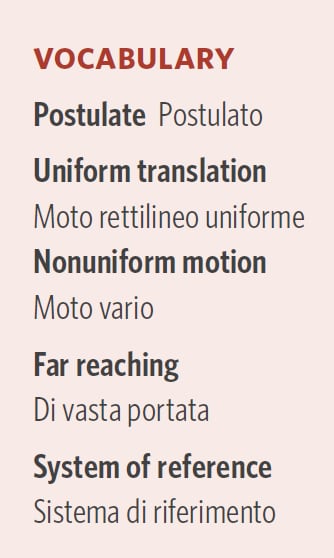Observations on the Special Theory of Relativity

CLIL - SCIENCE IN ENGLISH
La relatività generale poggia le sue basi sulla teoria della relatività ristretta o speciale: rappresenta la descrizione del moto relativo esteso anche a sistemi non inerziali, mentre la relatività ristretta si riferisce appunto ai soli sistemi inerziali. Formulata nel 1905, introduceva concetti fondamentali come quelli di spazio-tempo e di costanza della luce. Un modo per celebrare la relatività generale può essere quello di approfondire le sue origini. In questo brano ecco come lo stesso Einstein descrive l’evoluzione della sua teoria a partire dalle leggi della meccanica classica.

The special theory of relativity is based on the following postulate, which is also satisfied by the mechanics of Galileo and Newton.
If a system of co-ordinates K is chosen so that, in relation to it, physical laws hold good in their simplest form, the same laws also hold good in relation to any other system of co-ordinates K' moving in uniform translation relatively to K. This postulate we call the “special principle of relativity”. The word “special” is meant to intimate that the principle is restricted to the case when K' has a motion of uniform translation relatively to K, but that the equivalence of K' and K does not extend to the case of nonuniform motion of K' relatively to K.
Thus the special theory of relativity does not depart from classical mechanics through the postulate of relativity, but through the postulate of the constancy of the velocity of light in vacuo, from which, in combination with the special principle of relativity, there follow, in the well-known way, the relativity of simultaneity, the Lorentzian transformation, and the related laws for the behaviour of moving bodies and clocks.
The modification to which the special theory of relativity has subjected the theory of space and time is indeed far reaching, but one important point has remained unaffected.
For the laws of geometry, even according to the special theory of relativity, are to be interpreted directly as laws relating to the possible relative positions of solid bodies at rest; and, in a more general way, the laws of kinematics are to be interpreted as laws which describe the relations of measuring bodies and clocks. To two selected material points of a stationary rigid body there always corresponds a distance of quite definite length, which is independent of the locality and orientation of the body, and is also independent of the time. To two selected positions of the hands of a clock at rest relatively to the privileged system of reference there always corresponds an interval of time of a definite length, which is independent of place and time. We shall soon see that the general theory of relativity cannot adhere to this simple physical interpretation of space and time.
To find out more
Source: A. Einstein, The foundation of the general theory of relativity, reprinted from “The collected papers of Albert Einstein”, Volume 6, A. J. Kox, Martin J. Klein, and Robert Schulmann EDITORS, Princeton University Press, 1997, pag. 111-112.


